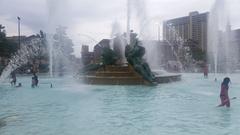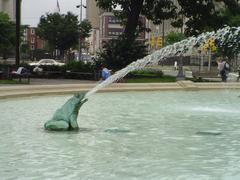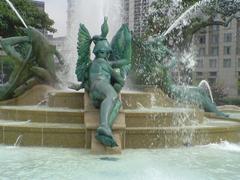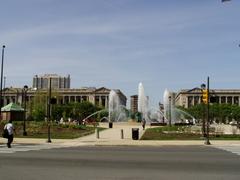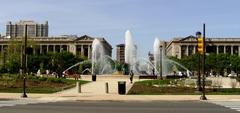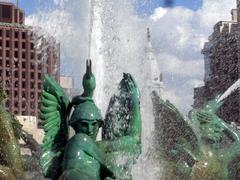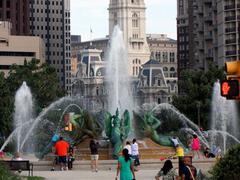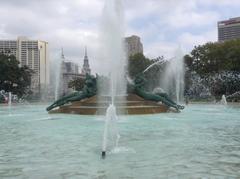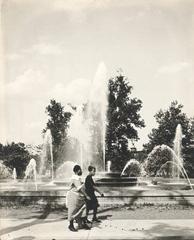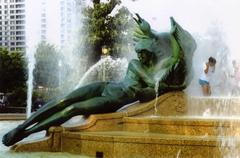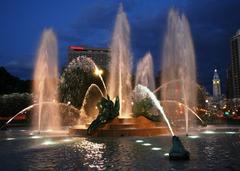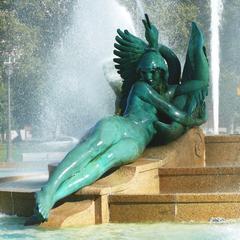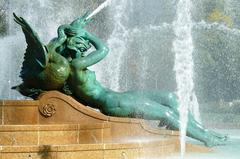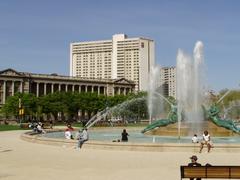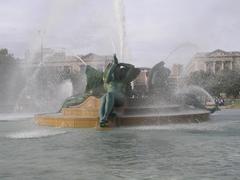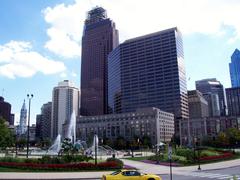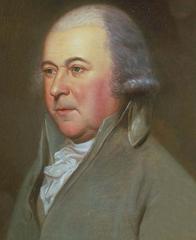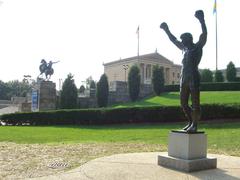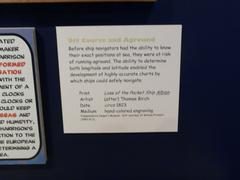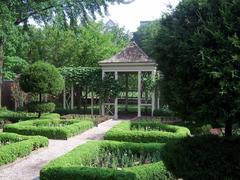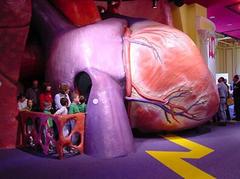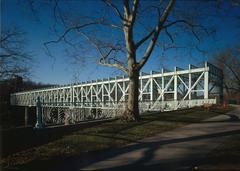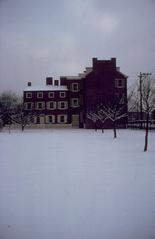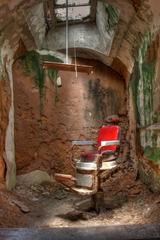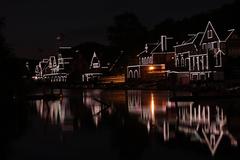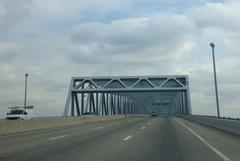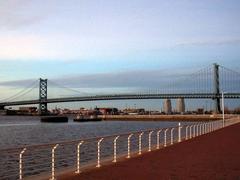
Comprehensive Guide to Visiting Swann Memorial Fountain, Philadelphia, United States
Date: 25/07/2024
Introduction
Discover the Swann Memorial Fountain, a stunning example of art deco design and a cherished landmark in Philadelphia. Located at the heart of Logan Circle, this iconic fountain offers visitors a glimpse into the city’s rich history and artistic heritage. Created in 1924 by sculptor Alexander Stirling Calder in collaboration with architect Wilson Eyre, the fountain was designed to honor Dr. Wilson Cary Swann, the founder of the Philadelphia Fountain Society. This society was dedicated to providing fresh drinking water throughout the city, a crucial public service in the 19th century when potable water was scarce and often contaminated (Association for Public Art). The Swann Memorial Fountain is not just a historical landmark but also a vibrant part of the community, serving as a social gathering spot and a symbol of Philadelphia’s commitment to public health and art. Whether you’re a history enthusiast, an art lover, or simply looking for a picturesque spot to relax, the Swann Memorial Fountain promises a memorable experience.
Table of Contents
History and Significance of Swann Memorial Fountain
Origins and Purpose
The Swann Memorial Fountain, also known as the Fountain of the Three Rivers, is an iconic art deco fountain located in the center of Logan Circle in Philadelphia, Pennsylvania. It was created in 1924 by sculptor Alexander Stirling Calder, in collaboration with architect Wilson Eyre, to honor Dr. Wilson Cary Swann, the founder of the Philadelphia Fountain Society. The society was dedicated to providing fresh drinking water throughout the city, a crucial public service in the 19th century when potable water was scarce and often contaminated (Association for Public Art).
Design and Symbolism
The fountain’s design is rich in symbolism and artistic references. Calder adapted the tradition of “river god” sculptures to create three large Native American figures representing Philadelphia’s major waterways - the Delaware River, the Schuylkill River, and Wissahickon Creek. The male figure, symbolizing the Delaware River, is depicted reaching above his head to grasp his bow as a large pike sprays water over him. The mature woman, representing the Schuylkill River, holds the neck of a swan, a nod to the Greek myth of Leda and the Swan. The young girl, symbolizing Wissahickon Creek, leans modestly on her side against an agitated, water-spouting swan (Wikipedia). The use of swans in the fountain is a clever pun on Dr. Swann’s name. Additionally, smaller bronze creatures such as frogs and turtles spout water toward the central geyser, adding to the dynamic visual effect of the fountain (Atlas Obscura).
Historical Context
Logan Circle, where the fountain is located, has a rich history of its own. Originally known as Northwest Square, it was one of William Penn’s original five squares in Philadelphia. The area was once used as a burial ground and later as a pasture. In 1821, it was the site of the last public execution in Philadelphia. By 1825, the square was renamed for James Logan, and it eventually transformed into one of the city’s most beautiful spots, featuring the Swann Memorial Fountain as its centerpiece (USHISTORY.org).
Public Reception and Cultural Impact
The Swann Memorial Fountain was unveiled to the public on a hot July day in 1924, attracting a crowd of ten thousand people who danced the tango in the surrounding streets to the music of the police band. This grand opening highlighted the fountain’s immediate impact on the community and its role as a social gathering spot (Association for Public Art). The fountain also played a role in the Temperance Movement, which Dr. Swann was actively involved in. By providing fresh drinking water, the Philadelphia Fountain Society aimed to discourage the consumption of alcohol, which was often considered safer to drink than the contaminated water available at the time. At its peak, the society maintained over 80 drinking fountains throughout the city (Billy Penn).
Architectural and Artistic Significance
The Swann Memorial Fountain is not only a tribute to Dr. Swann but also a significant piece of public art. It stands as the midpoint on the Benjamin Franklin Parkway, which features sculptures by three generations of the Calder family. Alexander Milne Calder, Stirling Calder’s father, designed the statue of William Penn atop City Hall, while Stirling Calder’s son, Alexander Calder, created the mobile “Ghosts” at the Philadelphia Museum of Art. This familial artistic legacy has led to the local wit referring to the three sculptures as the “Father, the Son, and the Holy Ghost” (Wikipedia). The fountain’s design incorporates a central geyser that originally shot water 50 feet into the air, though it typically spouts around 25 feet today. The interlacing water jets and sprays were meticulously designed by Wilson Eyre to create a visually stunning effect. The bronze figures and animals, set on granite bases, add to the fountain’s grandeur and artistic value (Association for Public Art).
Visitor Information
Visiting Hours and Tickets
The Swann Memorial Fountain is accessible to the public 24 hours a day, year-round. There are no tickets required to visit the fountain, making it an affordable and accessible attraction for all visitors. However, the best time to visit is during daylight hours when the fountain’s features can be fully appreciated.
Travel Tips
- Location - Logan Circle, Philadelphia, PA 19103
- Best Time to Visit - Spring and summer months when the fountain is operational, and the surrounding area is vibrant with activity.
- Nearby Attractions - The fountain is strategically placed along the Benjamin Franklin Parkway, offering stunning views of City Hall to the east and the Philadelphia Museum of Art to the west. Other nearby attractions include the Franklin Institute, the Barnes Foundation, and the Rodin Museum.
- Accessibility - Logan Circle and the Swann Memorial Fountain are wheelchair accessible. The surrounding area is pedestrian-friendly, with plenty of benches and shaded spots for relaxation.
- Special Events - The fountain and Logan Circle often host various events throughout the year, including outdoor concerts, festivals, and public gatherings. Check local event listings for up-to-date information.
- Photography Tips - The fountain’s dynamic water displays and artistic sculptures offer excellent photo opportunities. Early morning or late afternoon light provides the best conditions for capturing stunning images.
Conclusion
In summary, the Swann Memorial Fountain is a testament to Philadelphia’s commitment to public art, historical preservation, and community well-being. Its rich history, artistic significance, and cultural impact make it a must-visit landmark for anyone exploring the city. Whether you’re a history enthusiast, an art lover, or simply looking for a picturesque spot to relax, the Swann Memorial Fountain promises a memorable experience.
FAQ
Q: What are the visiting hours for the Swann Memorial Fountain?
A: The fountain is open 24 hours a day, year-round.
Q: Is there an admission fee to visit the Swann Memorial Fountain?
A: No, visiting the fountain is free of charge.
Q: Are there any guided tours available?
A: While there are no official guided tours specific to the fountain, several city tours include Logan Circle and the Swann Memorial Fountain as part of their itinerary.
Q: Can I swim in the fountain?
A: Although swimming in the fountain is a long-standing tradition, the city occasionally enforces swimming bans for safety reasons. Always check local guidelines before taking a dip.
Q: What are some nearby attractions?
A: Nearby attractions include the Philadelphia Museum of Art, the Franklin Institute, the Barnes Foundation, and the Rodin Museum.
Stay up-to-date with the latest events and news about the Swann Memorial Fountain by following us on social media or downloading our mobile app, Audiala.
References
- Association for Public Art. (n.d.). Swann Memorial Fountain. https://www.associationforpublicart.org/artwork/swann-memorial-fountain/
- Wikipedia. (n.d.). Swann Memorial Fountain. https://en.wikipedia.org/wiki/Swann_Memorial_Fountain
- Atlas Obscura. (n.d.). Swann Memorial Fountain. https://www.atlasobscura.com/places/swann-memorial-fountain
- USHISTORY.org. (n.d.). Swann Memorial Fountain. https://www.ushistory.org/districts/parkway/swann.htm
- Billy Penn. (2021). Swann Memorial Fountain history. https://billypenn.com/2021/04/08/swann-memorial-fountain-history-philadelphia-execution-northwest-square-temperance-movement/
- Waymarking. (n.d.). Swann Memorial Fountain. https://www.waymarking.com/waymarks/WM7JN8_Swann_Memorial_Fountain_Philadelphia_PA
- CBS News. (2023). Logan Square Swann Fountain turns 100. https://www.cbsnews.com/philadelphia/news/logan-square-swann-fountain-turns-100-history-philadelphia/
- City Cast Philly. (n.d.). From the archives: Swann Memorial Fountain. https://philly.citycast.fm/history-archive/from-the-archives-swann-memorial-fountain
- The Geographical Cure. (n.d.). Historic sites in Philadelphia. https://www.thegeographicalcure.com/post/historic-sites-in-philadelphia
- Visit Philly. (n.d.). Swann Memorial Fountain. https://www.visitphilly.com/things-to-do/attractions/swann-memorial-fountain/
